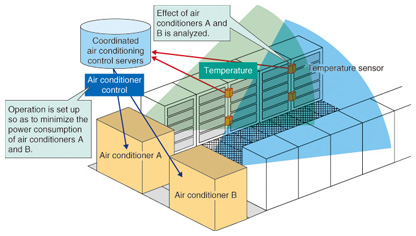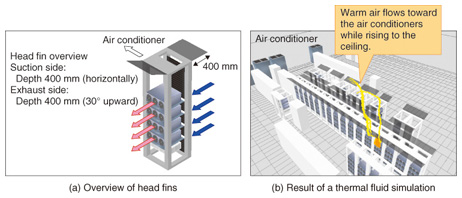 |
|||||||||||||||||
|
|
|||||||||||||||||
|
Feature Articles: Technologies for Managing Smart Energy Vol. 10, No. 1, pp. 11–16, Jan. 2012. https://doi.org/10.53829/ntr201201fa2 Energy Management of Telecommunication Buildings and DatacentersAbstractThis article introduces work being done by NTT Energy and Environment Systems Laboratories on energy management technologies for datacenters and telecommunication facilities to achieve energy savings by integrating and collaboratively controlling various developed technologies such as low-power-consumption servers and routers, highly efficient air conditioning for communication equipment rooms, and higher-voltage direct current power feeding.
1. IntroductionConsidering that over 90% of the total energy consumed by NTT is electricity and that the demand for datacenters is expected to increase as upper-layer services progress in the future, efforts to reduce CO2 emissions and save energy will become more essential. An overview of the energy management of telecommunication buildings and datacenters is shown in Fig. 1. To achieve energy savings in information and communications technology (ICT) equipment, the latest central processing units (CPUs) have been developed to eliminate unnecessary electricity usage by changing their operating frequencies and core voltages while maintaining their loads [1]. Moreover, routers and switches now feature energy saving capabilities based on varying the operating clock frequencies and stopping power feeding for unused ports and line interfaces [2]. Furthermore, for air conditioning equipment, efforts have been made to achieve higher efficiency in the air conditioning environment through equipment performance improvements, aisle capping* [3], and other means. In power feeding systems, a technology for improving the efficiency of the power supply equipment has been developed utilizing higher-voltage direct current (HVDC) power feeding [4].
On top of all these energy saving technologies, research and development (R&D) has been conducted at NTT Energy and Environment Systems Laboratories on the following: ICT equipment task allocation control, which dynamically controls load allocation and network topology for air conditioning systems to operate efficiently; coordinated control of ICT equipment air conditioning to improve tracking capabilities to match the heat source allocation; power supply control, which stops supplying unnecessary electric power to standby devices; and a datacenter energy management system (DEMS), which integrates and collaboratively controls these technologies. In addition, we are verifying the effects of the DEMS, which reflects NTT’s networking technologies, air conditioning guidelines, and power feeding guidelines.
2. Allocation control of ICT equipment tasksThe leading-edge datacenters of today are equipped with a capability for optimizing electric power by logically varying the working servers in response to load fluctuations by using server virtualization. For example, if the load requires only 25% of the servers in a datacenter to operate in order to provide services, the power consumption can be reduced by concentrating the processes in 25% of the servers and stopping the others. On the other hand, if we regard the servers as a heat load with respect to the air conditioners, if this heat load is distributed evenly rather than allocated spatially in a concentrated manner, then hot and cold spots are not easily formed, so efficient operation can be attained. An example of analysis by thermal fluid simulation is shown in Fig. 2. In Fig. 2(a), some hot and cold spots have been formed owing to the unevenness of the heat load, while Fig. 2(b) shows the possibility of air conditioners being operated efficiently without any hot or cold spots through heat load distribution.
The servers still consume some electric power even though their operating system is not running. The coordinated control of servers, air conditioning, and power feeding reduces electric power consumption by stopping power supply to servers that are not providing services and even stopping some of the power feeding equipment. We have also been working on the following. For datacenters, power consumption reduction by wide area relocation has been studied by applying server virtualization among datacenters at many different sites and applying a distributed replication block device [5]. For networks, energy savings have been addressed by performing dynamic routing and by stopping network equipment such as interfaces by through the use of traffic monitoring. 3. Coordinated control of ICT equipment and air conditionersAs a result of recent energy saving efforts, leading-edge ICT equipment can now automatically control its energy consumption in response to the load. This capability is utilized in new air conditioning systems, such as Federspiel Advanced Control System (FACS) from Viglient Corporation, which have been developed to provide efficient cooling without loss by tracking the amount of heat generation [6]. FACS achieves coordinated operation of multiple air conditioners by collecting information from many temperature sensors placed in the same room to analyze the effectiveness of each air conditioner. Our R&D has made further advances to achieve proactive air conditioning control technology by adding a feature for estimating heat load fluctuations. The concept of the proactive air conditioning control is shown in Fig. 3. In temperature-sensor-based air conditioning operation, heat generation varies along with changes in ICT equipment load and the sensors detect the heat load with a time lag. For this reason, we need to allow a margin in the supply air temperature in order to operate the ICT equipment safely. In proactive air conditioning technology, air conditioners are controlled to follow heat generation by collecting the characteristic quantities of ICT equipment such as CPU utilization and traffic and estimating changes in heat generation. Thus, the supply air temperature margin becomes smaller, which enables us to reduce the electric power needed for the air conditioning equipment.
4. Coordinated control among air conditionersMore than one air conditioner is usually installed in a telecommunication machine room. Since each air conditioner is operated autonomously by built-in sensors, there is the problem of lower efficiency due to interference among adjacent air conditioners. Experimental results for both autonomous and coordinated operations using three air conditioners are shown in Figs. 4 and 5. When the air conditioners were operated autonomously, only one of the three was supplying cooling air while the rest operated in ventilation mode. On the other hand, when we manually adjusted the load balancing of the air conditioners, total efficiency was improved.
On the basis of the results, we have been engaged in R&D of coordinated air conditioning control technology in which multiple air conditioners automatically work in collaboration. The coordinated air conditioning control is outlined in Fig. 6. A coordinated air conditioning server gathers temperature readings from many temperature sensors placed within a telecommunication machine room and assesses the effect exerted by each air conditioner. The server also distributes the load of multiple air conditioners so as to minimize their total power consumption while meeting the set range of target control temperature for each sensor. Efficient cooling of a machine room can be attained by this coordinated air conditioning control technology whereby multiple air conditioners operate ideally in collaboration with each other.
5. Airflow controlFor technology such as air conditioning control to function effectively, racks and equipment must be provided in an adequate environment. Most rack-mount servers are of the type with a front air supply and a rear exhaust. On the other hand, network equipment comes in various types in terms of the positions of air supply and exhaust openings, with a mixture of position pairs: front air supply & rear exhaust, bottom air supply & top exhaust, and side air supply & side exhaust. Since a front air supply/rear exhaust type is preferred for the air supply and exhaust of racks, an additional device called a diffuser is necessary in order for communication equipment having various air supply and exhaust positions to be mounted on the racks. We are conducting a study on diffusers that enable equipment already installed in racks to be easily worked upon. Moreover, as for aisle capping, there are some challenging issues such as installation cost and ICT equipment maintenance after installation. We are addressing these issues by utilizing some knowledge of thermal fluid dynamics to develop airflow control technology that attains the same degree of effectiveness but is easier to install. An example of air flow control plates (head fins) to be attached to the top surface of a rack is shown in Fig. 7. The head fins control the path of exhausted air so that it does not go round to the air supply side.
6. Future developmentWe intend to conduct further R&D of equipment control technologies and airflow control technologies such as a DEMS with the aim of achieving a society that has low CO2 emissions and big energy savings. References
|
|||||||||||||||||

















